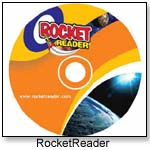 |

Tools:








Learning on the FlyEducational Software Evolves With Technology
| "We believe that 'application everywhere' will be the standard for the future. This means that students, teachers, parents and professionals will want access to their educational resources wherever they are." —Dr. Simon Ronald, RocketReader |
Today, knowledge can be acquired almost anywhere. The latest educational software must meet the needs of the 21st century by allowing independence and mobility as well as by teaching specific skills, manufacturers told TDmonthly Magazine.
Learn Fast
"We believe that 'application everywhere' will be the standard for the future," remarked Dr. Simon Ronald, CEO of RocketReader. "This means that students, teachers, parents and professionals will want access to their educational resources wherever they are."
With an online interface that doesn't require Java or Flash, the RocketReader speed-reading software works in school and at home, even on a dial-up connection.
 Ronald first released his program as shareware in 1996. Based on feedback from customers, he enhanced the product. In 2002, he introduced RocketReader Kids, RocketReader Vocab and a collection of 5,000 classic books on DVD. The goal of RocketReader is for users to reach an average reading speed of 500 words per minute, as opposed to the average speed of 230 words per minute. Ronald first released his program as shareware in 1996. Based on feedback from customers, he enhanced the product. In 2002, he introduced RocketReader Kids, RocketReader Vocab and a collection of 5,000 classic books on DVD. The goal of RocketReader is for users to reach an average reading speed of 500 words per minute, as opposed to the average speed of 230 words per minute.
Change Fast
Manufacturers have also had to increase the speed at which their products evolve.
“The major setback is the constantly changing technology — it is a blessing and it is a problem," explained Marge Cappo, who heads the consulting firm Learning in Motion, with Mike Fish. "You have to continue to invest in a product to keep it current. The Internet has definitely changed the educational software market."
Learning in Motion, founded in 1993, works with educational publishers on print and technology products in addition to designing software.
Tom Guthery IV, an award-winning animator and founder of Flix Productions, released his Animated Alphabet in 1990 based on knowledge acquired from textbooks obtained from his mother, an elementary school teacher for more than 20 years. In the "early days" of designing programs, he scanned the drawings and colored them on the computer before progressing to 3D Max.
"The technology seems light-years ahead of what I worked with back then — I now work with dual processor workstations and terrabytes of hard-drive space," Guthery commented.
Sell Fast
 Joe Wiseman, president of INNOVA Multimedia, along with John Maddock, started the company in 1994 with the release of Poetry in a Nutshell, their first CD-ROM. They offer curriculum-specific software for primary through high school students as well as educational multimedia for businesses and organizations. Joe Wiseman, president of INNOVA Multimedia, along with John Maddock, started the company in 1994 with the release of Poetry in a Nutshell, their first CD-ROM. They offer curriculum-specific software for primary through high school students as well as educational multimedia for businesses and organizations.
"Online subscription usage of content will eventually outsell CD-ROM and hard disk content for schools," Wiseman predicted. "It is currently more cost effective, but the infrastructure — financial and bureaucratic — is not there to support this initiative."
Greater access to education through computers has opened the industry door to new software companies and increased opportunities for those already established as the 21st century changes the way we learn. What follows is more information on educational software that is keeping pace with technology:
This program teaches children to read by developing whole-word recognition skills. It includes 83 graded lessons with pronunciation and spelling using sounds and letters. The software measures a child's progress with 1,000 common words, adapting the results to the individual's needs. Dr. Simon Ronald, CEO of RocketReader, cites competition for attention such as computer games, the Internet and television as the cause for a lack of interest in reading, so he commissioned writers to create riveting stories targeting specific age groups for his software. ToyDirectory Product ID#: 8712 (added 7/25/2006) . TD
This program teaches preschool and kindergarten children letter sounds using upper- and lowercase letters, integrating long and short vowels. Correct answers are rewarded with silly 3D animation. All menu items and directions are read aloud to the student. “I keep the curriculum and game elements separate so the students don’t become distracted during the learning activities,” said Flix Productions founder Tom Guthery IV. “I think of it as the ‘ice-cream principle’ — you have to finish dinner before you get dessert.” ToyDirectory Product ID#: 8713 (added 7/25/2006) . TD
This program teaches primary math skills using a carnival-like market to encourage participation. Students visit a series of stands operated by colorful characters that require help. Available in a signing version for the deaf and hearing impaired. ToyDirectory Product ID#: 8714 (added 7/25/2006) . TD
This software is designed for the deaf and hard-of-hearing. Each volume teaches a different language skill, utilizing matching games and pop quizzes. Mainstream students can use the program also. Windmill Works specializes in software for the hearing impaired and offers other mainstream products such as trivia, e-books and a card game. President Billie Pagliolo holds a degree in deaf education and her husband, Michael Olmon, is a software engineer. Because existing programs weren’t always appropriate for Pagliolo’s special-needs students, she used her knowledge of syntactical structures to help them learn specific linguistic rules. “There isn’t a lot out there for deaf and hard-of-hearing students,” Pagliolo explained to TDmonthly. ToyDirectory Product ID#: 8715 (added 7/25/2006) . TD
These individual software programs target a specific grade with language, math, science and social studies in a fun format that features animated sea creatures. The student explores creative lessons with Little Blue and his friends. The lessons were written by teachers. ToyDirectory Product ID#: 8716 (added 7/25/2006) . TD
THIS BANNER IS AN AD:

• • • • • • • • • • • • • • • • • • | • • • • • • • • • • • • • • • • • • |
Back to TDmonthly's front page
|  |
Advertise on TDmonthly

|

